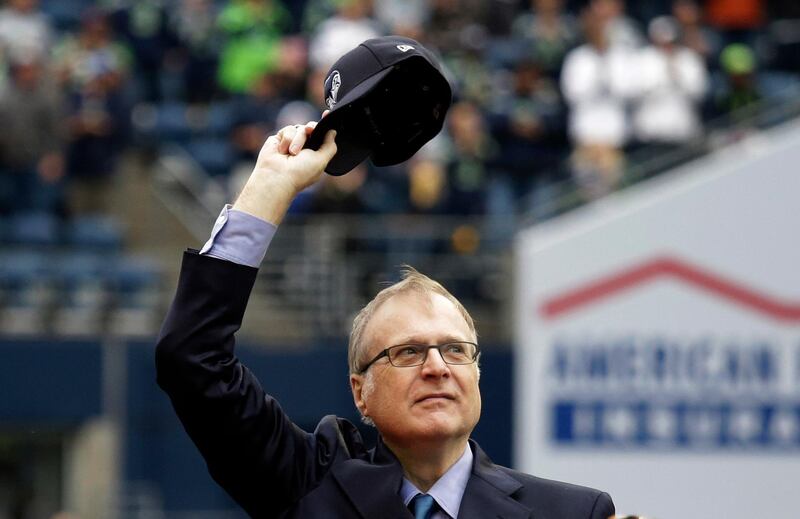Paul Allen
Two months before the first public exhibition of Paul Allen’s art collection, the curator found himself inside the billionaire’s box at the Super Bowl XL in 2006, rooting for his team.
While the Seattle Seahawks lost, the after-party was a riot, with Mr Allen jamming on guitar and actor Dan Aykroyd accompanying him on harmonica.
“We rocked till 2 or 3 in the morning,” the curator, Paul Tucker, said earlier this week, after Mr Allen’s death at age 65.
Mr Tucker, an art scholar who played football in college, said he doesn’t know what will become of the collection, a vast trove that spans centuries from antiquities to contemporary art and that may be worth more than $1 billion, according to sources.
Mr Allen, who co-founded Microsoft with Bill Gates and was the world’s 27th-richest person at the time of his death, was driven by passion and curiosity.
“He collected for enjoyment,” says Pablo Schugurensky, who presided over a significant expansion of Mr Allen’s trove as his director of art collections from 1998 to 2005. “He was extremely curious about all periods and all things.”
Mr Allen knew what he wanted and was ambitious about collecting, Mr Schugurensky says. “He would always try to find out what the proper top bid would be. Sometimes he would go out of the range because the piece was so important.”
A lover of Monet, Mr Allen was the anonymous buyer of the French painter’s 1891 canvas of a haystack for $81.4 million, then an auction record, at Christie’s in 2016, according to sources. The bidding war lasted 14 minutes.
“To live with these pieces of art is truly amazing,” Mr Allen said in 2015. “I feel that you should share some of the works to give the public a chance to see them.”
That year, he sent a group of works from his collection on a touring exhibition, “Seeing Nature: Landscape Masterworks from the Paul G Allen Family Collection,” which included pieces by Vincent Van Gogh, Edward Hopper and Gustav Klimt.
Mr Allen wasn’t averse to taking advantage when art prices skyrocketed. In 2016, a day before he bought Monet’s haystack, he sold a painting of a war jet by Gerhard Richter for $25.6m, more than double what he paid for it a decade earlier. In 2014, he sold one of his Rothkos for $56.2mafter acquiring it in 2007 for $34.2m.
Buying art turned out to be “a very, very good investment for me,” he said in 2015. “I didn’t go into it thinking this way. I thought some of the prices were very substantial when I bought them. But the market has been on such a tear.”
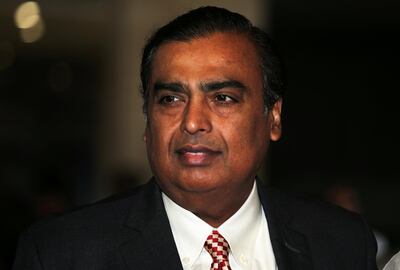
Mukesh Ambani
Within two years, India’s richest person turned the local mobile-phone market into the world’s biggest consumer of wireless data. But along the way, billionaire Mukesh Ambani laid waste to profits in the overcrowded industry by driving down prices to as low as zero.
Mr Ambani leads Reliance Jio Infocomm, which has gone from zero to more than 200 million subscribers, all of them on a nationwide 4G network, since 2016. While the user growth has come at the expense of smaller rivals who’ve merged or quit the market, the thrust into the country’s No. 3 spot for wireless carriers has also ravaged profit at Bharti Airtel, and Idea Cellular. The latter has merged with Vodafone Group’s India unit to overtake Bharti as the market’s biggest operator.
Meanwhile, Reliance Jio, a unit of Ambani’s energy-to-retail conglomerate Reliance Industries, has reported two quarters of profit, driven by subscription growth that has continued even after the company began charging for data services.
Consumers have been the clear winners, as the cost of sending and receiving data wirelessly has plummeted.
The plunge in prices has led to surge in data traffic to 1.5 billion gigabytes a month last year, according to Amitabh Kant, chief executive of NITI Aayog, India’s government policy think tank.
“Mobile data consumption is higher than USA & China put together,” Mr Kant posted on his Twitter account in December 2017.
While users benefit from declining prices, losses are expected to continue at the country’s big three surviving carriers. Bharti will probably report an 8.1 billion rupee ($110 million) net loss for the three months ending on September 30, according to the average of analyst estimates.
The Cellular Operators Association of India expects more losses ahead for the industry.
Prior to Jio’s entry into the market, India had more than 10 wireless providers, with the smallest five accounting for about 21 per cent and Bharti, the largest, taking up 25 per cent.
Since Jio stormed in with introductory free data and voice services, the market has consolidated into three big providers, including Vodafone Idea, which completed its merger at the end of August.
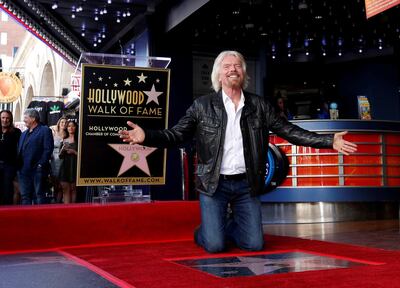
Richard Branson
Billionaire entrepreneur Richard Branson recalled an era of high living earlier this week as he added a star on the Hollywood Walk of Fame to his list of accomplishments.
Mr Branson, 68, the maverick British businessman behind Virgin Group ventures into airlines, record stores and space travel, unveiled his star with the help of singers Lance Bass and Ben Harper - two of the many musicians he signed to his Virgin Records label.
"Running a record company can be a lot of fun, and yes, it did involve sex, drugs and rock 'n roll," Mr Branson said.
Mr Branson, who was knighted by Britain's Queen Elizabeth in 2000, regaled crowds of well-wishers at the Hollywood ceremony with tales of taking Janet Jackson in a hot air balloon ride to entice her to sign with Virgin, giving British singer Boy George a refuge when he was trying to kick a heroin habit, and encountering Rolling Stones guitarist Keith Richards naked.
Mr Branson said he was especially delighted to sign the Rolling Stones to Virgin Records in 1992.
Mr Branson founded Virgin Records in 1972, choosing the name because he lacked business experience. It went on to sign some of the biggest names in music, including the Spice Girls, the Sex Pistols and Roy Orbison, before being sold in 1992 to fund Branson's Virgin Atlantic Airways venture.
Mr Branson also opened Virgin Megastores, selling music, games and DVDs around the world, before most were closed about 10 years ago due to the rise of digital music.
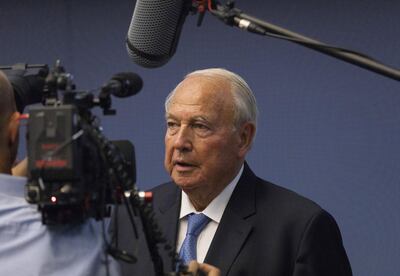
Heinz Hermann Thiele
Heinz Hermann Thiele is about $6bn richer following last week’s initial public offering of his largest asset, Knorr-Bremse, the world’s biggest maker of truck and train braking systems. The IPO makes him the country’s fourth-richest person, with a net worth of $15.3bn, according to Bloomberg.
Mr Thiele's rise in the ranking now puts him ahead of shipping billionaire Klaus-Michael Kuehne and SAP co-founder Hasso Platner. The 77-year-old remains about $8.7bn behind Germany’s richest person, Lidl Stiftung & Co.’s Dieter Schwarz.
Knorr-Bremse was founded in 1905, and Mr Thiele started there in 1969 as a legal specialist in the patents department. He rose through the ranks before buying the company in 1985. At that point Mr Thiele hadn’t even repaid the mortgage on his house.
Under Mr Thiele, Knorr-Bremse has expanded its global presence to more than 30 countries and posted 2017 sales of 6.2 billion euros ($7.2 billion). The shares have gained 1.5 per cent since the IPO.
Mr Thiele, who plans to hand over the business to his daughter, said in an interview that estate planning factored into his decision to list the company. The IPO comes two years after a reform to Germany’s inheritance tax law that increases the burden on single heirs of large family companies.
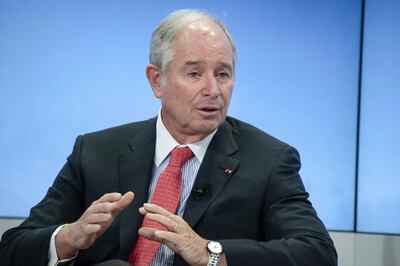
Stephen Schwarzman
Stephen Schwarzman, head of Blackstone Group, has given $350m - his largest personal gift - to help establish a college of computing at the Massachusetts Institute of Technology.
The MIT Stephen A Schwarzman College of Computing is part of a $1bn commitment from the university and will address the opportunities and challenges produced by the prevalence of computing and the rise of artificial intelligence, the Cambridge, Massachusetts-based school said last week.
Mr Schwarzman, who has a net worth of $12.8 billion, splashed onto the big-giving scene in 2008 with $100m to the New York Public Library.
His name will be on a campus center at Yale University for his $150m gift. He also created the Schwarzman Scholars programme at Tsinghua University in Beijing to educate future global leaders about China. He’s contributed and raised funds for the program totaling $578m to date.
Earlier this year, he gave $25m to his public high school in Abington, Pennsylvania, to expand science and technology instruction. The school was to be renamed after him but criticism from the community shelved those plans.
